
Source: 2cm, Zhihu, China Electric Network, etc.
Reprinted from: Global Internet of Things Observation
Published by: Internet of Things Think Tank
Please indicate the source and origin when reprinting
– —— 【Introduction】 ——
By 2020, each household will have up to 50 devices connected to the internet, and the standards for connectivity will not be limited to Wi-Fi, but will also include technologies such as Bluetooth, Zigbee, and Thread, prompting an urgent demand for mesh networking.
If the fragmentation issue can be resolved, the interoperability of different standards and the integration of various devices will make the prospects for smart home connectivity promising.
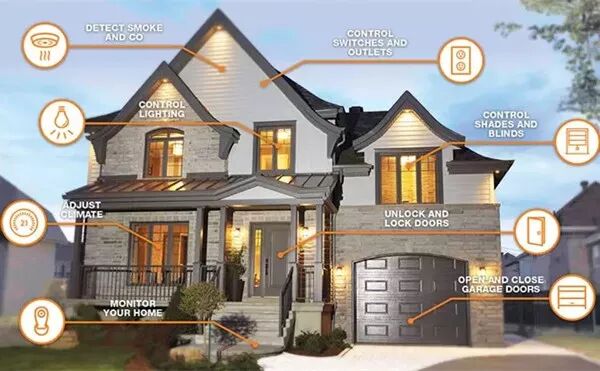
The potential for development in the smart home industry has attracted significant capital investment, with traditional hardware companies, internet firms, and real estate home decoration companies all vying for a share of the smart home market. Numerous tech companies, including Google, Apple, Microsoft, Samsung, Huawei, Xiaomi, and Meizu, have entered the fray. Meanwhile, the continuous advancement of mobile communication technologies is providing robust technical support for the smart home industry, with clear commercialization timelines for 5G technology, Bluetooth 5, and next-generation Wi-Fi standards.
From a demand perspective, the number of connected devices and the volume of data transmission in households are increasing year by year, with appliances such as air conditioners, gaming consoles, televisions, and wireless speakers all set to connect to the internet.
According to a GSMA report, in 2012, each household had about 8 terminal products connected to a Wi-Fi router, while by 2020, this number is expected to rise to as many as 50 devices, with connectivity standards expanding beyond Wi-Fi to include Bluetooth, Zigbee, and other technologies, driving an urgent need for mesh networking.

The Internet of Things (IoT) is set to be a key topic this year, as the number of connected devices in homes continues to grow. In the coming years, these devices are expected to evolve from their current fragmented and independently connected state to a structured mesh network. Coupled with several key developments in the industry over the past two years, such as smart voice assistants, manufacturers are increasingly sensing the business opportunities in connected smart homes and are proposing solutions for home wireless connectivity.
Building Momentum Again
The concept of smart homes has been around for over 20 years, and while major companies have invested heavily, the overall results have been largely unsuccessful. Observing from a network architecture perspective, it appears that wireless personal networks (WPAN) like Bluetooth, wireless local area networks (WLAN) like Wi-Fi, and control networks using protocols such as 802.15.4 (Zigbee, Thread, etc.) have matured. These standards typically operate in the 2.4GHz or Sub-GHz frequency bands and provide low-cost integration solutions that also support mesh network architectures.
Additionally, the rise of Amazon Echo in 2016 established it as the central hub for smart home control, sparking a wave of development for smart voice assistants. Dialog Semiconductor’s product marketing manager, Tong Wei, pointed out that the company’s low-power smart home solutions support the Apple HomeKit development platform. Furthermore, Google and Amazon are expected to be the three major platforms in this field. In addition to the convenience and support of development, the usability of voice assistants like Alexa, Siri, and Google Assistant, along with the richness of their services, are also key factors for success.

From a practical application perspective, Hugo Swart, senior director of product management at Qualcomm Atheros, stated that connected home applications are essentially a microcosm of the IoT. Due to the fragmented nature of IoT applications, devices with different standards will coexist in the same environment. In the future, long-range wide-area network applications for smart meters—water, electricity, and gas meters—will also be one of the endpoints for home connectivity. Companies that can integrate these different standard network devices will stand out easily.
Rahul Patel, senior vice president and general manager of connectivity technology at Qualcomm, noted that the IoT is rapidly transforming the connectivity technologies and network architectures for home automation. The connectivity standards, vertical ecosystem, and output and control platforms vary among manufacturers, leading to increased complexity in home networks and further complicating user network experiences.
Each Showcasing Their Strengths
Qualcomm, Silicon Labs, Dialog Semiconductor, and ARM are all actively proposing home wireless connectivity solutions. Below is a brief introduction to the technologies and products from each company:
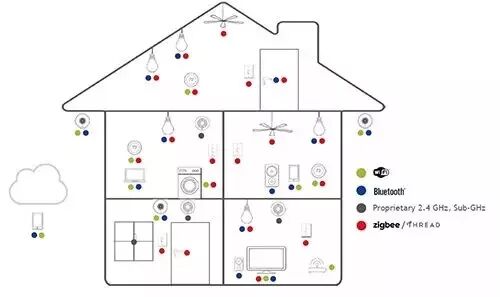

ARM Advanced RISC Machines Japan Official Website: https://www.arm.com/
As a licensor of embedded processor cores, ARM has launched the mbed platform, which includes software, hardware, and cloud management solutions for the IoT era, in addition to its expertise in processors. This includes the mbed OS for system-level management and mbed Cloud for cloud management. Through acquisitions, ARM has established a wireless communications division to provide the necessary short-range and medium-to-long-range wireless transmission technology IP for IoT.
The ARM mbed program began in Cambridge, UK, primarily collaborating with chip manufacturers and development board vendors to provide high integration and security for IoT device development. Currently, there are about 250,000 developers using mbed. ARM’s IoT business group Asia market director, Pan Shaoqi, stated that through mbed, developers can manage devices uniformly via a unified cloud platform, facilitating unified management and firmware updates. The mbed OS also provides the necessary connectivity for IoT, from short-range options like Bluetooth Low Energy, Ethernet, Wi-Fi, and Thread, to long-range options like 4G and NB IoT, offering a complete resource set.
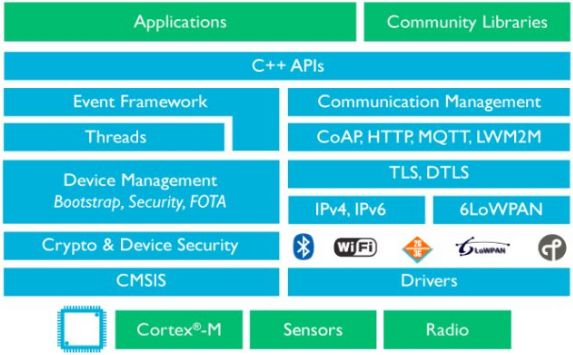
ARM’s embedded cores have developed successfully in recent years, establishing a high brand recognition in the industry. The company’s wireless communications division’s technical marketing manager, Dou Zhencheng, stated that Cotex and Radio combine to form Cordio, a solution that supports Bluetooth, Zigbee, and Thread standards, targeting smart home and wearable applications. Additionally, smart home connectivity applications also include some long-range application needs, with Cordio-N specifically addressing NB-IoT IP.
As we move into the IoT era, smart homes are likely to be a mixed application environment of multiple networks, standards, and specifications. ARM has specifically proposed solutions for both short-range and long-range networks, recognizing the market potential of these applications. This may lead to scenarios where both short-range and long-range transmission needs exist at the same node, allowing for the design to share the same processing core and integrate different radio IPs, simplifying node design, reducing costs, and increasing integration.

Qualcomm Technology United States Official Website: https://www.qualcomm.com/
The increasing complexity of home networks poses challenges for average users, particularly for older family members. Consequently, network service providers need to spend considerable time educating the public on how to use networks, indirectly incurring significant costs for customer service calls and on-site repairs. To reduce connectivity complexity and customer service costs, network service providers should offer consumers a more robust network architecture as a response strategy.
Rahul Patel, senior vice president and general manager of connectivity technology at Qualcomm, discussed three key demands from network operators:
First, a platform that can automatically start and repair issues;
Second, ensuring the security of the network environment and personal privacy;
Third, providing a network architecture that covers the entire home.
To address these demands, Qualcomm has launched the Qualcomm Mesh Networking Platform, which integrates numerous technologies to meet the three major demands of operators, assisting OEM manufacturers and broadband telecom operators in providing next-generation connected home experiences. Devices equipped with the Qualcomm Mesh Networking Platform will be designed to provide robust and consistent connectivity for various smart home devices, including features such as voice control, centralized management, and essential mesh system functionalities required by various telecom operators.
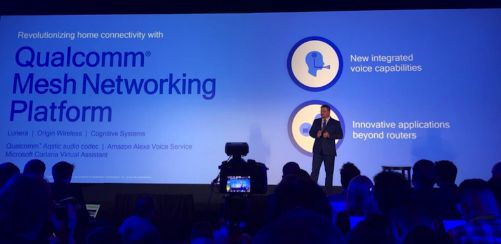
Patel noted that prior to 2016, the usage of Mesh Routers was low, but as network complexity increased, the demand for Mesh Routers grew. By the end of 2016, 23% of users had adopted Mesh Routers, and it is estimated that by 2018, more connected products will enter homes, with over 50% of consumers expected to purchase Mesh Router-related products, while the usage of standard routers will decline year by year.
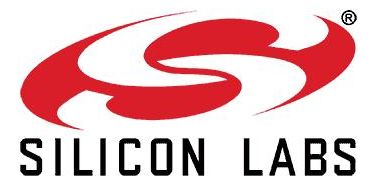
Additionally, Qualcomm has proposed a smart home solution that uses the QCA 4020 tri-band system-on-chip (SoC) to form an IoT Hub. The QCA 4020 supports Bluetooth 5 low energy, dual-band Wi-Fi, and IEEE 802.15.4, including Zigbee and Thread, facilitating the integration of all home devices within the IoT Hub.
Qualcomm has also integrated Google’s voice solution, allowing users to simply issue voice commands through their smartphones to the IoT Hub to add newly purchased devices to the home network, simplifying the complex setup process. The QCA 4024 supports Bluetooth 5 low energy and 802.15.4, serving as a streamlined, low-cost version for endpoint nodes.
Silicon Labs United States Official Website: http://www.silabs.com
Focusing on home automation, connected lighting, wearable devices, and industrial IoT, Silicon Labs showcased the EFR32xG12 Wireless Gecko solution, emphasizing RF performance, enhanced security encryption accelerators, larger memory capacity options, internal capacitive touch, and additional low-power peripherals and sensor interfaces.
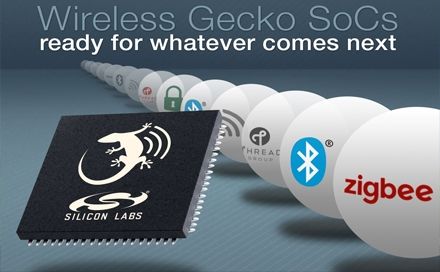
Jason Rock, senior strategy marketing manager for IoT products at Silicon Labs, explained that the EFR32xG12 series supports Zigbee and Thread mesh networks, Bluetooth 5, and proprietary wireless protocols. Silicon Labs has achieved efficient switching between different network protocols by optimizing its wireless protocol stack architecture. For example, device manufacturers can deploy and configure devices via Bluetooth on smartphones using a single chip, and then connect them to Zigbee or Thread mesh networks to link dozens or even hundreds of endpoint nodes.
To ensure IoT security, the EFR32xG12 SoC includes a second internal security accelerator specifically for multi-protocol radios and a NIST-certified true random number generator (TRNG). This additional hardware encryption block operates with the latest security algorithms, providing higher performance and lower power compared to traditional software implementations. Jason Rock emphasized that the security of connected devices is becoming increasingly important, with the Thread standard incorporating more security measures to prevent IoT hacking or cybersecurity threats.
Acuity Brands Lighting, a market leader in indoor and outdoor lighting, control, and energy management solutions, stated that multi-protocol connectivity brings more advanced features, helping to simplify connected lighting control designs while meeting consumer demands for easy installation and online updates to extend product lifespans. Silicon Labs’ Wireless Gecko platform provides us with multi-protocol SoCs, modules, robust software protocol stacks, and powerful development tools to help our network-controlled LED devices and control products reach the market quickly.

Dialog Semiconductor United States Official Website: https://www.dialog-semiconductor.com/
Smart home applications are diverse, and Dialog has categorized its applications into four types:
The first category includes control applications such as smart plugs, smart lighting, and remote controls;
The second category includes security applications such as smart door locks, door and window sensors, and smoke/CO detectors;
The third category includes energy applications such as HVAC, thermostats, and sensors;
The fourth category includes comfort applications such as smart appliances, proximity tags, and beacons.
Each of these four application categories has different requirements. Dialog Semiconductor’s product marketing manager, Tong Wei, explained that security applications emphasize reliability, safety, low power consumption, miniaturization, and fast response times, while energy applications focus on reliability, safety, low power consumption, advanced sensor support, and miniaturization. Comfort applications require reliability, safety, low cost, advanced sensor support, and fast response times, while control applications emphasize reliability, low cost, miniaturization, and fast response times.
Currently, Dialog has provided support for Bluetooth standards with the DA1458x series and DA14680 products. The DA1458x series is low power, small in size, and has a lower system cost, making it suitable for simpler applications like beacons and proximity tags. The DA14680 is a single-chip solution for wearable devices, integrating Bluetooth, microcontroller (MCU), and charging functions, requiring only sensors and batteries to complete a full wearable solution.
Conclusion
The complex environment of the IoT and the fragmented nature of applications are significant bottlenecks currently driving development. Therefore, focusing on a relatively small scope that is closely related to everyone’s daily life, such as the home, may be a breakthrough approach.
If the fragmentation issue can be resolved, along with the interoperability of different standards and the integration of various devices, a complete mesh network can be developed in homes, making the vision of smart homes no longer just a slogan, but also contributing to the future development and application of larger IoT systems.

Previous Hot Articles (Click on the title to read directly):
-
《How Difficult is it to Create Smart Locks for Shared Bicycles?》
-
《Cognitive Computing, Blockchain IoT, IoT Security… Those Who Understand Will Control the Future》
-
《【Heavy Release】2017-2018 China IoT Industry Panorama Report—The IoT Has Initiated Deep Changes in the Industry》span>
-
《【Heavy】IoT Industry Panorama Report, The First Domestic IoT Industry Two-Dimensional Perspective Panorama》
-
《A Cartoon Explains: Besides WiFi and Bluetooth, What Can the Recently Popular NB-IoT Do?》
-
《A Cartoon Explains: Behind NB-IoT, What is the LoRa Everyone is Talking About?》
